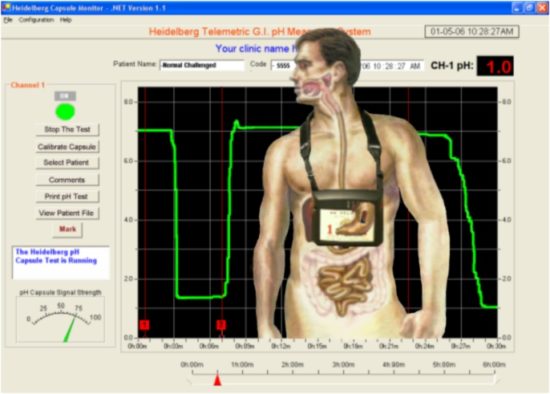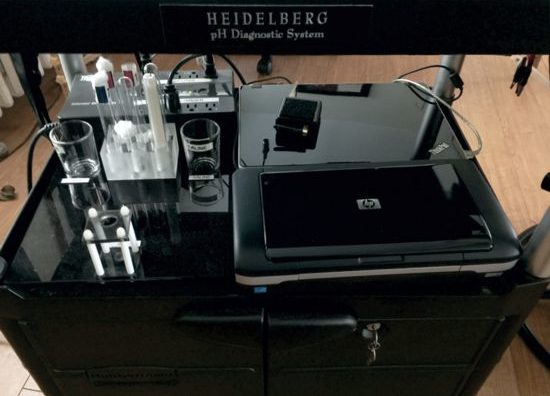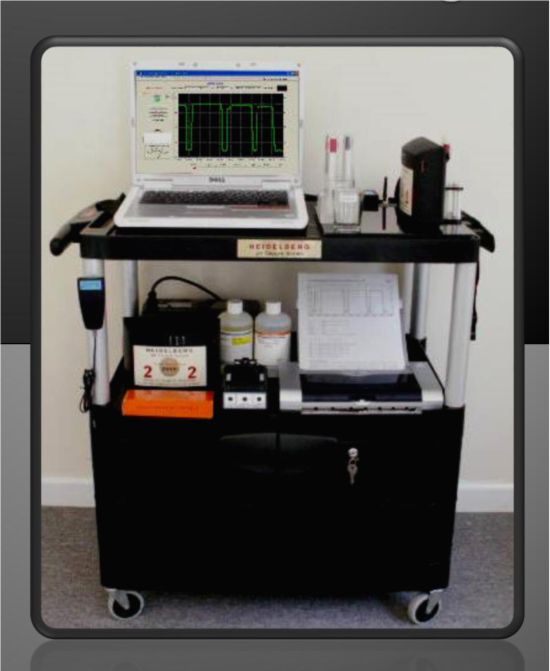
The stomach, by secreting hydrochloric acid and the hormone pepsin, plays a key role in food digestion. When our ability to make hydrochloric acid is compromised, poor digestion, poor absorption and gastrointestinal infection may result, which can lead to a host of health problems. Diagnosis of low stomach acid (Hypochlorhydria) can be obtained by performing a gastric pH analysis test. Treatment of Hypochlorhydria consists of supplementing with “acid” pills in the form of Betaine HCL.
The stomach plays a key role in maintaining the integrity of the individual in the face of an environmental challenge as it relates to the food that we eat.
The average individual will process about a ton of food and drink every month! It’s the way that we handle and sort out this load that is very important in ensuring that the nutrients that we need get into the body and the chemicals, bacteria, toxins stay out.
The stomach plays a vital role in this process. By secreting hydrochloric acid and the hormone pepsin, it allows us to do the following:
- Break down and partially digest protein to prepare it for its next port of call in the duodenum and jejunum (the upper parts of the small intestine) for further breakdown into its component parts, the amino acids.
- Dissolve and put the minerals in our food into a solution so as to be absorbable further down the gastrointestinal tract.
- Kill any potential disease-causing bacteria and parasites which could potentially infect the intestines and allow their permanent unwanted residence in our bowels.
This means that the maintenance of optimal gastric function is vital to the maintenance of good health.
Terminology
Here is a quick review of the terminology associated with stomach acid problems.
- Hyperchlorhydria: means the production of too much tummy acid. This can cause corrosion of the stomach lining leading to the stomach and duodenal ulcers.
- Hypochlorhydria: this where the stomach doesn’t make enough acid to do the job of handling food intake and performs its responsibilities in an inefficient way.
- Achlorhydria: this is when the stomach makes no acid at all, its lining cells are flat and non-functioning. This condition is called atrophic gastritis.
How prevalent is hypochlorhydria?
It appears from research done in the ’40s at John Hopkins University and the Mayo Clinic that low stomach acid was found in 30% of people by the age of 40, 60% by the age of 60 and 70-75% by ages of 70 to 75!
How relevant is this? Isn’t this a normal effect of aging? Yes, it may be, but so is death. It has been common practice over the last 40 years to ignore this phenomenon in people and has been brushed aside as irrelevant by the traditional medical community.
However, hypochlorhydria and achlorhydria can lead to consequences in our health that are non-optimal and deleterious.
The Adverse Effects of Hypochlorhydria
These include:
Malnutrition
a. Amino acid deficiencies due to poor digestion and assimilation of protein. Low-grade amino acid deficiencies can be associated with muscle wasting, immuno-deficiency, nervous system dysfunction and reduce liver detoxification.
b. Multiple mineral deficiencies particularly of calcium, iron, magnesium and possibly selenium, chromium, manganese, copper and other trace minerals.
Deficiencies of these minerals can further cause ill health and increased risk of degenerative diseases.
c. Vitamin B12 deficiency. This is particularly seen in achlorhydric patients where there is no production of intrinsic factor. This is a chemical compound produced by the stomach which tags onto vitamin B12 released from protein in the stomach and carries it down the intestine to allow B12 to be absorbed in the lower part of the small intestine.
Food Intolerances
When protein is poorly digested, partially digested fragments can gain access to the body and initiate an activation of the immune system causing conditions associated with food intolerance, e.g. arthritis, rhinitis, asthma, eczema, urticaria (hives) and colitis.
Colon Toxicity
An increased lead of undigested protein fragments can get to the colon and feed a section of the flora there which overgrow, produce poisonous substances (like ammonia and various biogenic amines) which are toxic to the body if allowed access to the general circulation. This is called the putrefaction of the bowel.
Conditions Associated with Hypochlorhydria
These are numerous and include:
- Patients with autoimmune disease. These diseases include Type 1 diabetes, thyroiditis, lupus erythematosus, rheumatoid arthritis, pernicious anemia, multiple sclerosis and so on. Clinical observation has elucidated that hypochlorhydria is present in 90% of lupus, 80% in rheumatoid arthritis and 60% in multiple sclerosis.
- Patients on gastric acid inhibitory drugs and antacids are often hypochlorhydric before they even started these drugs in about 90% of the cases!
- Asthma, especially in childhood. The incidence is around 80%.
- Osteoporosis in 90% of patients, as those patients with hypochlorhydria, cannot assimilate calcium and other minerals well which are vital for bone integrity.
Signs and Symptoms of Low Stomach Acid
- Capillary dilatation in the cheeks. This gives a rosy red complexion. There is a very high correlation with gastric hypoacidity, especially in younger persons.
- Fingernails that break easily. This is generally seen in women. Nails tend to be paper-thin, crack, chip or layer back.
- Hair loss in women. One also sees this in women who are pregnant, on oral contraceptive pills or estrogen replacement therapy and in folic acid deficient individuals.
- Abdominal bloating in the upper part with consumption an animal protein, especially beef, when food just “sits there like a rock” and doesn’t “digest” well.
- Burping and belching.
- Constipation.
Diagnosis
This is best done by performing the Heidelberg gastric pH analysis test.
This involves swallowing a capsule the size of a large multivitamin and mineral which has within it a pH electrode and a radio transmitter. The signal given off is sent to an antenna which the patient wears around the stomach in the form of a belt and the result is shown on a large machine which visualizes pH readings.
When safely swallowed and in place, resting stomach pH is measured. Except in severely achlorhydric patients, it is usually acid (pH of 1.8 to 2.3). The stomach is then made to work by the patient swallowing a known amount of sodium bicarbonate. When this is done, the stomach becomes alkaline and then acid is made to bring down the pH to the baseline.
In the abnormal stomach, this occurs within 20 minutes after 4 or 5 challenges. The reacidification time is delayed in these individuals with hypochlorhydria.
This procedure is very reliable in diagnosing sub-optimal gastric acidity states and confirms the clinical diagnosis.
Treatment
This usually involves swallowing “acid” pills in the form of Betaine HCL (with or without pepsin) or glutamic acid in fairly large doses (depending on the size of the meal eaten). The dose is usually four to six capsules of 650 mg capsules of Betaine HCL with a large meal.
Also, the stomach has to become acclimatized to this dose; so it is best to begin at one capsule during a meal and then increase by one capsule a week to the full dose.
Too much supplementation will cause stomach upset and therefore the dose should be adjusted accordingly. Smaller meals will require a lower dose.
Self-Medication
It is not advisable to supplement without being under the care of appropriate health care professional. In fact, many people do self-medicate with no major problems, but it does happen that a normal stomach could get very irritated if a person decided incorrectly that hypoacidity was a problem.
Summary
Gastric hypoacidity is a common problem and, as mentioned above, can be associated with many disease states and is often an underlying factor in chronic nutritional deficiencies in middle-aged and elderly people, even when an adequate diet and supplements are consumed.
Therefore, its presence needs to be thoroughly looked for and treatment instituted, as it is much more difficult to manage a patient as effectively without intervening and handling this condition.
In fact, treatment of low stomach acidity can make a somewhat improved patient into a very improved patient.

Many patients complain of digestive problems. These complaints are difficult to assess as various factors are implicated. Does the patient have hypochlorhydria, hyperchlorhydria, achlorhydria, pyloric insufficiency or heavy mucus? The Heidelberg pH Diagnostic System can accurately diagnose these conditions. It is also useful in the diagnosis of heavy mucus in the stomach, gastric ulcers, acute or sub-acute gastritis, stomach emptying syndrome, dumping syndrome and delayed stomach emptying.
HOW DOES THE HEIDELBERG pH DIAGNOSTIC SYSTEM WORK?

The Heidelberg pH Diagnostic System is a diagnostic tool that measures the pH levels in the digestive tract. This is accomplished by the use of a high-frequency radio transmitter capsule that the patient swallows. The pH capsule measures 7.1 mm in diameter by 15.4 mm in length and is encapsulated within polyacrylate (plastic), which makes for ease of swallowing. A specially designed, physiologic battery provides the power required to operate the transmitter. The Heidelberg pH capsule is NOT RADIOACTIVE.
The pH capsule is activated, calibrated and then swallowed. The patient wears a transceiver around his/her neck via a suspension strap. The frequencies transmitted by the capsule are picked up by the transceiver that converts the information to digital data and sends it to a computer where it displayed on a graph on a monitor. On completion of the test, a printout of the test information is reviewed by a doctor for diagnosing.
The Heidelberg pH Diagnostic System eliminates the psychological and physiological trauma associated with the use of the “INFAMOUS” STOMACH TUBE.
ADMINISTRATION
The tethered pH capsule is swallowed with one ounce of water. It reaches the stomach usually within 2 to 3 seconds. Once in the stomach, the exposed tether is attached by medical tape to the patient’s cheek to prevent migration out of the stomach. The capsule can be removed by using the small-attached string. With the capsule in place, the fasting stomach pH is measured and then a 5 cubic centimetres dose of a saturated solution of sodium bicarbonate is administered orally to the patient. The purpose of this challenge is to determine parietal cell activity and re-acidification time. The test takes between 45 minutes and 2 hours to complete. The Heidelberg pH capsule cannot be sterilized and is used for one application and one patient only.
PREPARATION
Medical history is obtained and the results of a recent complete physical examination are reviewed. The patient must not be taking any medication that will affect the test results. Protein pump inhibitors, acid-reducing medications, antihistamines, antibiotics are a few of the medications that will alter the test results. Some medications remain in the body long after they are stopped; therefore, the length of time and the quantity of the medication taken will determine how long it will be necessary to stop the medications before taking the test. The patient is fasting 12 hours prior to taking the test. Consent must be obtained at the Centre. The test must not be conducted if any reservations are held by the patient about taking the test.
HISTORY
Professor H.G. Noeller conducted a research study with 1000 patients at the University of Heidelberg’s Department of Gastroenterology in Heidelberg, Germany. He orally administered a 5 cubic centimetres dose of a saturated solution of sodium bicarbonate to each of these fasting patients. The purpose of this published study was to determine parietal activity and re-acidification time.
If your health practitioner referred you to our clinic please print and fill out